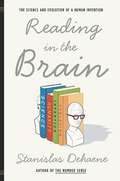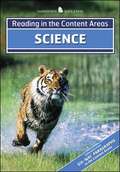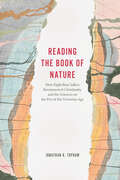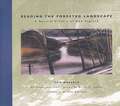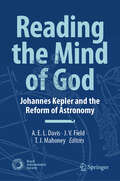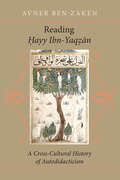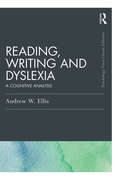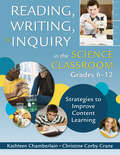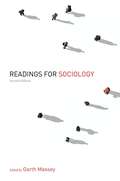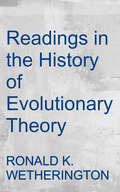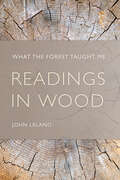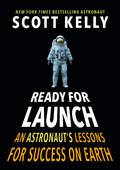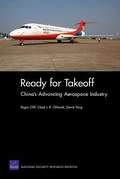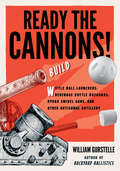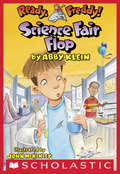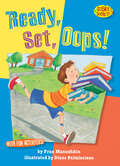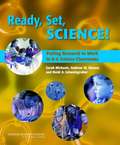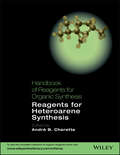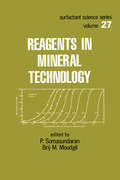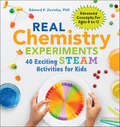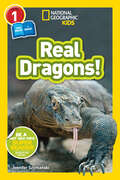- Table View
- List View
Reading in the Brain: The Science and Evolution of a Human Invention
by Stanislaus Dehaene"The transparent and automatic feat of reading comprehension disguises an intricate biological effort, ably analyzed in this fascinating study. Drawing on scads of brain-imaging studies, case histories of stroke victims and ingenious cognitive psychology experiments, cognitive neuroscientist Dehaene (The Number Sense) diagrams the neural machinery that translates marks on paper into language, sound and meaning. It's a complex and surprising circuitry, both specific, in that it is housed in parts of the cortex that perform specific processing tasks, and puzzlingly abstract. (The brain, Dehaene hypothesizes, registers words mainly as collections of pairs of letters.) The author proposes reading as an example of neuronal recycling--the recruitment of previously evolved neural circuits to accomplish cultural innovations--and uses this idea to explore how ancient scribes shaped writing systems around the brain's potential and limitations." -Publishers Weekly
Reading in the Content Areas: Science
by McGraw-Hill Jamestown Education StaffBased on the best-selling Six-Way Paragraphs books, these individual titles help students master the essential skills needed to organize, understand, and apply information in math, science, and social studies. Here are the books that will open doors for you into your content area classrooms.
Reading the Book of Nature: How Eight Best Sellers Reconnected Christianity and the Sciences on the Eve of the Victorian Age
by Jonathan R. TophamA powerful reimagining of the world in which a young Charles Darwin developed his theory of evolution. When Charles Darwin returned to Britain from the Beagle voyage in 1836, the most talked-about scientific books of the day were the Bridgewater Treatises. This series of eight works was funded by a bequest of the last Earl of Bridgewater and written by leading men of science appointed by the president of the Royal Society to explore "the Power, Wisdom, and Goodness of God, as manifested in the Creation." Securing public attention beyond all expectations, the series offered Darwin’s generation a range of approaches to one of the great questions of the age: how to incorporate the newly emerging disciplinary sciences into Britain’s overwhelmingly Christian culture. Drawing on a wealth of archival and published sources, including many unexplored by historians, Jonathan R. Topham examines how and to what extent the series contributed to a sense of congruence between Christianity and the sciences in the generation before the fabled Victorian conflict between science and religion. Building on the distinctive insights of book history and paying close attention to the production, circulation, and use of the books, Topham offers new perspectives on early Victorian science and the subject of science and religion as a whole.
Reading the Book of Nature: How Eight Best Sellers Reconnected Christianity and the Sciences on the Eve of the Victorian Age
by Jonathan R. TophamA powerful reimagining of the world in which a young Charles Darwin developed his theory of evolution. When Charles Darwin returned to Britain from the Beagle voyage in 1836, the most talked-about scientific books of the day were the Bridgewater Treatises. This series of eight works was funded by a bequest of the last Earl of Bridgewater and written by leading men of science appointed by the president of the Royal Society to explore "the Power, Wisdom, and Goodness of God, as manifested in the Creation." Securing public attention beyond all expectations, the series offered Darwin’s generation a range of approaches to one of the great questions of the age: how to incorporate the newly emerging disciplinary sciences into Britain’s overwhelmingly Christian culture. Drawing on a wealth of archival and published sources, including many unexplored by historians, Jonathan R. Topham examines how and to what extent the series contributed to a sense of congruence between Christianity and the sciences in the generation before the fabled Victorian conflict between science and religion. Building on the distinctive insights of book history and paying close attention to the production, circulation, and use of the books, Topham offers new perspectives on early Victorian science and the subject of science and religion as a whole.
Reading the Forested Landscape: A Natural History of New England
by Tom Wessels Brian D. Cohen Ann H. ZwingerLandscape is much more than scenery to be observed or even terrain to be traveled, as this fascinating and many-layered book vividly shows us. Etched into the land is the history of how we have inhabited it, the storms and fires that have shaped it, and its response to these and other changes. An intrepid sleuth and articulate tutor, Wessels teaches us to read a landscape the way we might solve a mystery. What exactly is the meaning of all those stone walls in the middle of the forest? Why do beech and birch trees have smooth bark when the bark of all other northern species is rough? How do you tell the age of a beaver pond and determine if beavers still live there? Why are pine trees dominant in one patch of forest and maples in another? What happened to the American chestnut? Turn to this book for the answers, and no walk in the woods will ever be the same.
Reading the Mind of God: Johannes Kepler and the Reform of Astronomy (Springer Praxis Books)
by J. V. Field T. J. Mahoney A. E. L. DavisThis volume provides a wide-ranging introduction to Kepler’s work, with essays on his religion, his cosmological theories, his work in astronomy, astrology, optics and mathematics and his interactions with Tycho Brahe and Galileo Galilei.Kepler is a major figure in the history of science. His laws of planetary motion overthrew a tradition, going back as far as the ancient Greeks, of constructing the paths of planets by combinations of circles; and the derivation of the laws was revolutionary in the way it relied upon detailed agreement with observations. Moreover, the laws explicitly relate the motion and path of each planet to the Sun. Thus, when the tables that Kepler based upon the laws proved to be highly reliable over many decades, this played a crucial part in making heliocentrism acceptable. And many years after Kepler’s death the laws themselves played an important part in Newton’s derivation of the inverse square law of gravitation in his Principia (1687). In this respect, Kepler can look ‘modern’. But his work is grounded in his religious belief that the Universe is the visible expression of the nature of the God who created it.This book, whose chapters are written by leading scholars, is primarily addressed to undergraduate and graduate students of science and the history of science but will also appeal to the general reader with an interest in the history of science.
Reading Ḥayy Ibn-Yaqẓān: A Cross-Cultural History of Autodidacticism
by Avner Ben-ZakenCommonly translated as "The Self-Taught Philosopher" or "The Improvement of Human Reason," Ibn-Tufayl's story Hayy Ibn-Yaqzān inspired debates about autodidacticism in a range of historical fields from classical Islamic philosophy through Renaissance humanism and the European Enlightenment. Avner Ben-Zaken's account of how the text traveled demonstrates the intricate ways in which autodidacticism was contested in and adapted to diverse cultural settings.In tracing the circulation of the Hayy Ibn-Yaqzān, Ben-Zaken highlights its key place in four far-removed historical moments. He explains how autodidacticism intertwined with struggles over mysticism in twelfth-century Marrakesh, controversies about pedagogy in fourteenth-century Barcelona, quarrels concerning astrology in Renaissance Florence, and debates pertaining to experimentalism in seventeenth-century Oxford. In each site and period, Ben-Zaken recaptures the cultural context that stirred scholars to relate to ayy Ibn-Yaqān and demonstrates how the text moved among cultures, leaving in its wake translations, interpretations, and controversies as various as the societies themselves. Pleas for autodidacticism, Ben-Zaken shows, not only echoed within close philosophical discussions; they surfaced in struggles for control between individuals and establishments. Presented as self-contained histories, these four moments together form a historical collage of autodidacticism across cultures from the late Medieval era to early modern times. The first book-length intellectual history of autodidacticism, this novel, thought-provoking work will interest a wide range of historians, including scholars of the history of science, philosophy, literature, Europe, and the Middle East.
Reading, Writing and Dyslexia: A Cognitive Analysis (Psychology Press & Routledge Classic Editions)
by Andrew W EllisThis is a classic edition of Andrew Ellis’ acclaimed introduction to the scientific study of reading, writing and dyslexia, which now includes a new introduction from the author. The book describes the remarkable skills of reading and writing – how we acquire them, how we exercise them as skilled readers and writers, and what can go wrong with them in childhood disorders or as a result of brain damage. The new introduction reflects on some key research developments since the book was first published. Reading, Writing and Dyslexia is an engaging introduction to the field which is still completely relevant to today’s readers. It will remain essential reading for all students of psychology and education, whilst also being accessible to parents and teachers.
Reading, Writing, and Inquiry in the Science Classroom, Grades 6-12: Strategies to Improve Content Learning
by Kathleen Chamberlain Christine Corby CraneThis resource covers reading and writing practices, science standards, and sample lessons to help educators successfully integrate literacy and science instruction in any classroom.
Readings For Sociology (Seventh Edition)
by Garth MasseyReadings for Sociology provides students with engaging selections that reveal the complexities of our social world and offer insights into sociological analysis. Garth Massey includes selections from popular and academic journals as well as lively book excerpts. All of the selections help students reach a new level of sociological understanding. While Readings for Sociology is comprehensive in its scope, offering a wide range of selections on the standard topics in the introductory course, its emphasis is particularly on social inequality and race, class, and gender.
Readings In The History Of Evolutionary Theory: Selections From Primary Sources
by Ronald WetheringtonThis collection of primary source readings covers the history of evolutionary theory from its roots in Classical Greece to the present. Beginning with excerpts from Plato and Aristotle, the volume proceeds chronologically through the time of Darwin and ends with a look at the revolutions in thought--such as evolutionary development biology--that carry the evolutionary narrative from Darwin to the current day. Wetherington begins each chapter with an overview that contextualizes the selections it contains. Vivid biographical sketches at the beginning of each reading illuminate the authors and the oeuvre out of which each work arose. These overviews and sketches are designed to assist students in drawing historical distinctions and parallels between the preceding and succeeding units of the book, while discussion questions at the end of each unit allow students to apply the history of evolutionary theory to their own lives. Suggestions for further reading are also provided so that students can pursue their study of evolutionary theory outside of the classroom.
Readings in Wood: What the Forest Taught Me
by John Leland“[Leland] brings the botanical into direct relationship with the spiritual, using a prose style that is as profound as it is pyrotechnic.” —Jim Warren, Washington and Lee UniversityAward-winning nature writer John Leland offers a collection of twenty-seven short, poetic essays that marry science and the humanities as the author seeks meaning in trees. Readings in Wood is an investigation of trees and forests and also of wood as a material that people have found essential in the creation of society and culture. Leland views with wit and erudition the natural world and the curious place of human beings as saviors and destroyers of this world.At once personal memoir, natural history, and cultural criticism, the book reflects Leland’s idiosyncratic vision. As vast as a forest, topics range from tree grain and leaf shape to economic theories, mathematics, and engineering. Readings in Wood is a hybrid testament of science, faith, superstition, and disbelief learned from sitting on tree trunks and peering at leaves and fungi. Leland hopes others will join him in nature’s classroom. Quite aware of the irony, he reminds us, “These leaves you desultorily turn over once hung in a green wood gone to make this book. Touching a book, you touch a tree. I pray that Readings in Wood’s essays, touching you, may justify in some small way the trees who died in their making.”“This book constitutes a hymn to the technical and the beautiful, a meander through the geography, geology, botany, mathematics and vigor of our plants, especially in the southern Appalachians.” —R. T. Smith, editor, Shenandoah, and writer-in-residence, Washington and Lee University“Informative, thoughtful, inspiring, and innately entertaining.” —The Midwest Book Review
Ready for Launch
by Scott KellyAstronaut Scott Kelly uses his unusual path to success to motivate everyone who thinks that shooting for the stars is beyond their reach in this gifty package, perfect for graduations and other life-changing moments.How did a distracted student with poor grades become the record-breaking astronaut and commander of the International Space Station? People think that astronauts are always perfect. "Failure's not an option," right? But Scott believes that it's our mistakes and challenges that can lead to greatness. Not everyone's road to achievement is a straight line up. Most of us need to navigate a bumpier road full of obstacles to get where we want to be. Using ten life-changing moments, Scott shares his advice for mastering fear and failure and using it to see the world with fresh eyes. Unusual lessons from his path to space can prepare everyone for success on the ground.
Ready for Launch: An Astronaut's Lessons for Success on Earth
by Scott KellyUsing ten life-changing moments from his path to space, astronaut Scott Kelly shares his advice for mastering fear and failure and turning our daily struggles into rocket fuel for success—the perfect gift for graduations and other milestone moments!In this insightful and funny read, Scott Kelly shares how a distracted student with poor grades became a record-breaking astronaut and commander of the International Space Station. People think that astronauts are always perfect. "Failure's not an option," right? But as Scott shares in his deeply intimate book, he believes that it's our mistakes and challenges that have the potential to lead to greatness. Not everyone's road to achievement is a straight line. Most of us need to navigate a bumpier road full of obstacles to get where we want to be. Scott&’s story is for everyone who believes that shooting for the stars is beyond their reach!
Ready for Takeoff: China's Advancing Aerospace Industry
by Roger Cliff David Yang Chad J. OhlandtAn assessment of China's aerospace manufacturing capabilities and how China's participation in commercial markets and supply chains contributes to their improvement. It examines China's aviation and space manufacturing capabilities, government efforts to encourage foreign participation, transfers of foreign technology to China, the extent to which U.S. and foreign aerospace firms depend on supplies from China, and their implications for U.S. security interests.
Ready the Cannons!: Build Wiffle Ball Launchers, Beverage Bottle Bazookas, Hydro Swivel Guns, and Other Artisanal Artillery
by William GurstelleFrom the author of Backyard Ballistics comes this new DIY handbook on building cannons and other fun things that shoot, from wiffle ball launchers and beverage bottle bazookas to super-powered water guns and model culverins. It combines military history and physics with do-it-yourself projects. Now ordinary folks can construct a dozen awesome artillery devices in their garage or basement workshops using inexpensive household or hardware store materials and this step-by-step guide. Clear instructions, diagrams, and photographs show how to build projects ranging from the simple supersonic ping-pong ball shooter to the more complex replica of the Napoleon Cannon. With a strong emphasis on safety, the book also gives tips on troubleshooting, tells the history of how and when the artillery devices were used, and explains the physics behind the projects. This book will be indispensable for the legions of backyard watergunners, model-rocket launchers, and fireworks fanatics who wish every day was the fourth of July.
Ready, Freddy! Science Fair Flop (Ready, Freddy! #22)
by Abby Klein John MckinleyEveryone's favorite first-grade shark expert is back! With more than 3 million copies sold, it's clear that kids are ready for Freddy! Now that Freddy's in first grade he needs a real science experiment for the school fair. But Freddy isn't a science whiz like his best friend, Robbie. When he finally comes up with a plan -- growing mold -- his mom accidentally throws it away! Can he recreate it in time? Or will the fair be a total flop?
Ready, Set, Oops! (Science Solves It!)
by Fran ManushkinJoey's running to the library--fast. Too fast! But his trips and tumbles won't help him come up with an idea for Science Day. Or will they?
Ready, Set, SCIENCE!: Putting Research to Work in K-8 Science Classrooms
by National Research Council of the National AcademiesWinner of the Association of Educational Publishers 2008 Distinguished Achievement Award. Filled with classroom case studies, this book demonstrates the most effective methods of helping students achieve science proficiency.
Reagents for Heteroarene Synthesis
by André B. CharetteThe Handbook is a compilation of 99 articles on diverse reagents and catalysts that describe the synthesis of heteroarenes, the building blocks of a wide range of chemicals used in pharma and chemical industries. Articles are selected from the e-EROS database and edited to make sure that it includes only the material relevant to the topic of the book and focus on the synthetic aspects. This makes the articles very focused on the needs of readers wanting information on specific syntheses of specific heteroarenes. In addition, the chemistry of each ?parent heteroarene? is also included to ensure that the reader rapidly finds important information. The Handbook is a part of the Handbook of Reagents for Organic Chemistry series, aiming at collecting articles on a particular theme that individual researchers in academia or industry can use on a daily basis.
Reagents in Mineral Technology (Surfactant Science Ser. #27)
by P. SomasundaranReagents in Mineral Technology provides comprehensive coverage of both basic as well asapplied aspects of reagents utilized in the minerals industry.This outstanding, single-source reference opens with an explicit account of flotation fundamentals,including coverage of wetting phenomena, mineral/water interfacial phenomena, flo tationchemistry, and flocculation and dispersion of mineral suspensions.It then discusses flotation of sulfide and nonsulfide minerals, with attention to formation ofclithiolates, formation of metal thiol compounds, application of fatty acids, sulfosuccinic acids,amines, and other collectors.Reagents in Mineral Technology also reviews adsorption of surfactants on minerals .. .details adsorption of polymers .. . and considers the chemistry and application of chelation agentsin minerals separations.Additional chapters consider grinding aids, frothers, inorganic and polymeric depressants,dewatering and filtering aids, analytical techniques, and much more.Unique in its depth of coverage, Reagents in Mineral Technology will prove an invaluablereference for mineral engineers and processors; analytical, surface, colloid, and physical chemists;petroleum, petrochemical, metallurgical, and mining engineers; and for use in advancedundergraduate- and graduate-level courses in these and related fields.
Real Chemistry Experiments: 40 Exciting STEAM Activities for Kids (Real Science)
by Edward P. ZovinkaReal Chemistry Experiments has 40 exciting and engaging experiments with a real-life STEAM (Science, Technology, Engineering, Art, Math) connection for kids 8-12.Full STEAM ahead! Become a better problem-solver, inventor, and innovator with these fascinating chemistry experiments. Each one has a clear purpose or question that's being asked, step-by-step instructions, a list of materials you'll need, questions to help you record your observations, and more. By the time you're through, you'll have chemistry for kids down to a science!This activity book includes experiments and activities with:Easy-to-find materials—From tap water and paper towels, to popsicle sticks and dish soap, the materials needed for these experiments are quick and easy to find.Real-life science—Learn the real chemistry behind how and why each experiment works, like why water and oil don't mix in Oily Oceans, how geodes form in Eggshell Geodes, and more.Chemistry basics—Get tons of info about chemistry and what it is, from the scientific method and the Periodic Table to atoms and the five main areas of study.Imagine all the things you can learn, create, and discover in this colorful book about chemistry—the sky's the limit!
Real Dragons! (National Geographic Kids Readers)
by Jennifer SzymanskiFind out about dragon-like critters in this new Co-reader from National Geographic Kids. Co-readers provide one page of text for adults to read aloud and one page text for kids to read aloud on each spread, building toward a collaborative reading experience.Think dragons exist only in fairy tales? Think again! Meet huge komodo dragons, flying lizards, and all sorts of amazing creatures that really are stranger than fiction. Adult and child readers will learn all about fierce and funny REAL dragons together. Co-readers are designed to be read aloud, with one page for the child who is learning to read and the adjacent page for a parent, caregiver, older sibling, buddy, or other more fluent reader. Expert-vetted text along with brilliant photos and a fun approach to reading are a winning formula with kids, parents, and educators.
